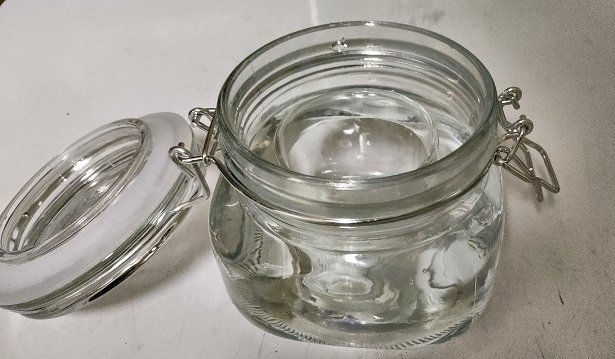Concerns about chlorine dioxide part 1.
There is some unreacted sodium chlorite in the solution when you mix it with the acid (activator). Isn't sodium chlorite toxic?
Yes.
There are 2 (TWO) cases of medically significant sodium chlorite poisoning reported in medical literature. Both recovered but required medical intervention.
In one case a man accidentally drank a 28% sodium chlorite solution. He was using it to decontaminate fruit. He made up the solution in a cup, and later accidentally mixed up the cup of sodium chlorite solution with a cup of water and drank the solution.
https://www.ncbi.nlm.nih.gov/pmc/articles/PMC3576492/
However, to be on the safe side, if you allow the chlorine dioxide to evaporate, and then the gas to go into solution in some distilled water, there will be no unreacted sodium chlorite.
The apparatus looks something like this. An airtight glass or ceramic container with a smaller glass or ceramic container inside (like a heavy shot glass) Fill the outer container with distilled water, mix up a small amount of solution in the inner container, seal, place in a dark place overnight, and voila! purified chlorine dioxide solution! Remove the inner container and discard the mixture (pour it down the sink, which will disinfect your drain!)
Keep it in the fridge until needed.

Get some chlorine dioxide test strips from Amazon to adjust the concentration (you want a maximum of about 40 ppm)
I would start with just a small amount of solution, test the outer container, and mix up more solution, let it sit overnight again. Repeat until you have the desired concentration.
To be on the safe side whenever you open the sealed container, do it under a vented range hood or do it outside.
There is some unreacted sodium chlorite in the solution when you mix it with the acid (activator). Isn't sodium chlorite toxic?
Yes.
There are 2 (TWO) cases of medically significant sodium chlorite poisoning reported in medical literature. Both recovered but required medical intervention.
In one case a man accidentally drank a 28% sodium chlorite solution. He was using it to decontaminate fruit. He made up the solution in a cup, and later accidentally mixed up the cup of sodium chlorite solution with a cup of water and drank the solution.
https://www.ncbi.nlm.nih.gov/pmc/articles/PMC3576492/
However, to be on the safe side, if you allow the chlorine dioxide to evaporate, and then the gas to go into solution in some distilled water, there will be no unreacted sodium chlorite.
The apparatus looks something like this. An airtight glass or ceramic container with a smaller glass or ceramic container inside (like a heavy shot glass) Fill the outer container with distilled water, mix up a small amount of solution in the inner container, seal, place in a dark place overnight, and voila! purified chlorine dioxide solution! Remove the inner container and discard the mixture (pour it down the sink, which will disinfect your drain!)
Keep it in the fridge until needed.

Get some chlorine dioxide test strips from Amazon to adjust the concentration (you want a maximum of about 40 ppm)
I would start with just a small amount of solution, test the outer container, and mix up more solution, let it sit overnight again. Repeat until you have the desired concentration.
To be on the safe side whenever you open the sealed container, do it under a vented range hood or do it outside.
